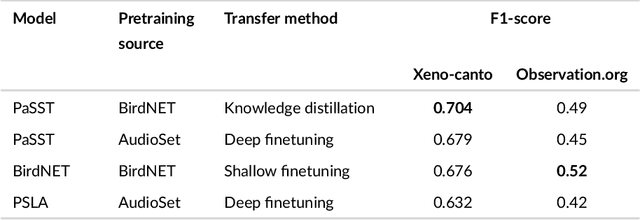Generalization in birdsong classification: impact of transfer learning methods and dataset characteristics
Paper and Code
Sep 21, 2024



Animal sounds can be recognised automatically by machine learning, and this has an important role to play in biodiversity monitoring. Yet despite increasingly impressive capabilities, bioacoustic species classifiers still exhibit imbalanced performance across species and habitats, especially in complex soundscapes. In this study, we explore the effectiveness of transfer learning in large-scale bird sound classification across various conditions, including single- and multi-label scenarios, and across different model architectures such as CNNs and Transformers. Our experiments demonstrate that both fine-tuning and knowledge distillation yield strong performance, with cross-distillation proving particularly effective in improving in-domain performance on Xeno-canto data. However, when generalizing to soundscapes, shallow fine-tuning exhibits superior performance compared to knowledge distillation, highlighting its robustness and constrained nature. Our study further investigates how to use multi-species labels, in cases where these are present but incomplete. We advocate for more comprehensive labeling practices within the animal sound community, including annotating background species and providing temporal details, to enhance the training of robust bird sound classifiers. These findings provide insights into the optimal reuse of pretrained models for advancing automatic bioacoustic recognition.
 Add to Chrome
Add to Chrome Add to Firefox
Add to Firefox Add to Edge
Add to Edge